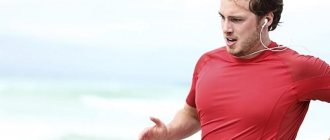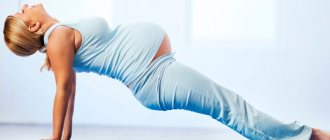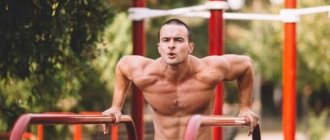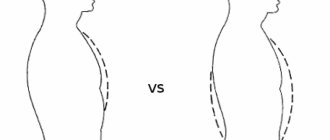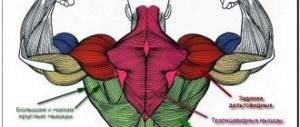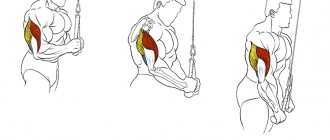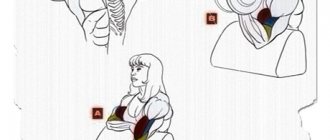The effectiveness of push-ups and other physical exercises depends on their correct execution. A common mistake many beginners and amateurs make is neglecting breathing techniques during training, since to achieve the desired effect you need to breathe correctly. Erratic inhalations, exhalations and air retention during physical activity can not only reduce their effectiveness, but also worsen well-being, and subsequently health.
Why is breathing so important?
Breathing is inherently an involuntary process carried out through instinct.
We are able to increase the flow of oxygen into the body by increasing the surface area of the lungs when we breathe. Each of us needs oxygen for metabolic processes in every cell of our body. Thanks to breathing exercises, its amount increases, and it becomes easier for a person to concentrate and mental activity improves.
Another reason why proper breathing is important is its ability to control prana.
Yogis have long noticed that the state of a person’s soul is interconnected with the characteristics of his breathing:
- when you are excited, breathing is shallow, fast, uneven;
- when calm - deep, unhurried, uniform.
If we purposefully work with our breathing, we can slow it down and make it deeper and more measured. This will lead to calmness of the psyche and mind.
Breathing techniques when performing exercises
The breathing rhythm depends on the exercise performed, but is based on general principles:
| Breath | Exercise phase | Moment of execution |
| Inhale | Previous | Before starting the exercise |
| Exhalation | Positive | Muscle contraction |
| Inhale | Negative | Muscle relaxation |
Inhalation and exhalation alternate along with performing the light and heavy parts of the exercise, respectively. In order for strong physical activity to be safe, a rigid spine is necessary, since the combined efforts of the muscles go through it. The spine is made strong by the core muscles, which include the muscles of the back, pelvic floor, as well as the oblique and rectus abdominis muscles. It is impossible to strain them when inhaling, while when exhaling, the task is simplified by the reflex action of breathing on them, carried out through the nervous system. During training, they breathe in the rhythm of their execution evenly and deeply, using diaphragmatic breathing.
To develop better control over breathing, you should begin to monitor it during warm-up. The described breathing pattern must be adapted to all exercises. To facilitate this process, there are descriptions of breathing technique options in individual exercises.
Push-ups
Push-ups, both from the floor and on the uneven bars, belong to the category of pressing exercises, in which breathing is of fundamental importance. When doing push-ups of any kind, all the muscles of the shoulder girdle receive the load; the triceps, anterior deltoids and chest muscles are the most tense. The muscles of the buttocks, spine and abdomen experience constant tension.
How to breathe correctly when doing push-ups is described below.
You need to breathe when doing push-ups from the floor in the following sequence:
- Having taken a lying position, bend your elbows, lowering your body down. At the same time, take a smooth breath through the nose, which ideally continues from the beginning to the end of the negative phase of the push-up.
- When lifting the body back, exhale more sharply through the mouth.
In addition to observing the rhythm of breathing, when doing push-ups from the floor correctly, you need to keep your buttocks no higher than your lower back, avoid rounding the cervical spine and keep your back straight. If there is a one-second break between sets, you do not need to breathe, but holding your breath while doing push-ups is not recommended.
Pull-up on the horizontal bar
An indicator of the optimal height of the horizontal bar is the crossbar, which can be touched by the palms of your raised hands when standing on your toes. If the crossbar is higher, breathing will be lost initially when jumping towards it.
Step-by-step description of breathing while pulling up:
- Grasping the bar, you need to slightly lift your feet back with your knees bent.
- Bringing your shoulder blades together, take a deep breath.
- During a leisurely ascent, exhale continuously throughout the entire process. It ends when the upper pull-up limit is reached.
- Inhalation is performed along with a smooth lowering of the body down.
It is not recommended to hold your breath between ascent and descent. The ideal rhythm would be a complete exhalation and a completed deep inhalation when reaching the upper and lower limits of the pull-up, respectively.
When squatting
Highly effective squats use different muscle groups; this exercise is successfully used both for gaining muscle mass and for losing weight. The body expends a large amount of energy when squats, and therefore it must be provided with a sufficient amount of oxygen. Proper breathing can not only cope with this, but also ease the most difficult moments of the exercise. Particular attention should be paid to breathing when squatting with additional weight.
Step-by-step description of breathing in squats:
- Having taken the starting position, you need to clear the lungs of carbon dioxide through a complete exhalation.
- Along with lowering down, you need to take a leisurely deep breath through your nose, your lips should be tightly compressed.
- When the hips reach a position parallel to the floor, inhalation is stopped, exhalation begins, along with an immediate rise back.
The exhalation should be more intense, which is why it may end half way up. You can also exhale through your mouth. When performing the exercise, your arms should not hang to the sides, otherwise the chest will not be able to expand. Between performing several sets of 10-15 repetitions of squats, take a mandatory break with at least 5 full breathing cycles. The purpose of the breaks is to fully restore it.
For strength exercises
When doing push-ups, weight-bearing exercises, weight-lifting exercises and other types of strength training, you need to breathe by exhaling at maximum effort and inhaling while relaxing the muscles. During heavy weight exercises such as barbell lifting, some athletes hold their breath, but this can be harmful to health. You need to exhale at least a little. If you cannot get rid of breath holdings with maximum effort, you should reduce the load or at least minimize them.
Exhalation when working with heavy weights can be slow and tense; it should not be as sharp as when performing other exercises. Sharp strength exercises have a corresponding exhalation.
During aerobic exercise
In addition to gymnastic exercises, this category also includes running, swimming, race walking and cycling. Air deficiency in aerobics reduces the rate of breakdown of fat cells, which is why training with improper breathing may be ineffective. Aerobics requires deep and even breathing using an inhalation-exhalation pattern identical to other exercises, and they must correspond to the intensity of the movements. When cycling at a speed of 15 km/h and below, one cycle of breathing is enough for two revolutions of the pedals; exhalation is done while lowering one of them.
At higher speeds or when cycling uphill, exhale as you lower the pedal of each leg down.
Running has its own rhythms of deep breathing, they are given with the number of steps for each breathing cycle (inhalation-exhalation):
| Breathing rhythm | Number of steps for 1 inhalation and 1 exhalation |
| Ordinary | 3/3 |
| Standard | 2/2 |
| Accelerated | 1/1 |
The usual rhythm of diaphragmatic breathing in running is also used in race walking, in which you inhale through the nose and exhale through the mouth. They begin to practice it at a slow pace, spending 10 minutes on the exercise. As you train, the pace and walking time increase (the average is 30 minutes). The workout ends with 5 minutes of walking at a slow pace to fully restore breathing. Learning proper breathing techniques while swimming is a little more difficult due to the aquatic environment. You need to inhale through your nose above the surface of the water, and exhale through your mouth under water.
Water is denser than air, so it will take more effort to breathe sufficiently. Inhalation should be done so that it is audible, but for exhalation, all the strength of the lungs is used, which gradually adapt to this breathing technique. The pattern of inhalation during relaxation and exhalation during effort is also used in water sports; it may have additional features depending on the type of exercise.
For flexibility
When performing exercises in this category, exhalation is carried out during stretching. A deep breath is taken when taking the starting position. Unlike most types of training, flexibility exercises have a long exhale.
Squats
This exercise uses the muscles of the abs, hips, buttocks and lower back. His breathing technique has some differences from standard squats.
Step-by-step description of breathing when squatting with a barbell:
- First, you should take a deep breath, exhale sharply and approach the bar.
- Standing under the rack with the apparatus, it is placed on the shoulders, lifting the barbell with a straight back and legs apart and walking away to perform the exercise. If this takes time, you need to breathe evenly and deeply during the process.
- Having exhaled completely, inhale and begin lowering the body into a squat.
- The rise back is done along with a leisurely exhalation, releasing air through the nose or clenched teeth.
- The remaining air is exhaled sharply, straightening up with the barbell.
- The exercise is continued by squatting with a new breath without breaks and straightening the knees.
It is recommended to do squats with a barbell after regular ones, performing them as a breathing warm-up.
Yoga
When performing yoga, the body assumes static positions. Smooth and unhurried diaphragmatic breathing promotes increased muscle tone. You should inhale with movements that expand the chest, and exhale with movements that compress. These include, for example, the position of a straight body with arms down and bending forward with hands touching the floor, respectively. Many yoga techniques involve holding the breath, but they should only be performed as directed by a trainer.
Burpee
The breathing technique in the burpee exercise, which is universal in its benefits, has 2 breathing cycles per repetition.
Step-by-step description of breathing during burpees:
- After taking the lying position, push-ups are performed, inhaling when lowering the body and exhaling when rising.
- The next inhalation is done when the legs come together with the arms, and the exhale is done when jumping up.
- The sequence is repeated the required number of times.
A little about pranayama
According to one version, the term comes from the merger of two words in Sanskrit: “prana” - the energy of life and “yama” - management, control. Thus, pranayama is a technique for consciously controlling the breath.
Yogis are confident that the human body works correctly because prana enters it:
- through the eyes;
- through the nose;
- with food.
However, the modern world is far from ideal. We have forgotten about harmony with nature. We eat foods that are not very natural, breathe polluted air, and are in a stream of stressful information.
Because of this, the subtle body of a person becomes polluted. The symptoms are well known to many:
- decreased immunity;
- fatigue and loss of strength;
- absent-mindedness;
- drowsiness.
Pranayama helps a person to restore strength and cleanse the pollution of the subtle body caused by lifestyle.
It will also allow you to accumulate energy that can be used for complex tasks and projects. For the effect to be noticeable, exercises should be performed regularly.
From a physiological point of view, the following can be noted about pranayama:
- breathing involves different groups of respiratory muscles;
- the ratio of oxygen and carbon dioxide changes in the body;
- internal organs are massaged;
- a reflex effect on the brain and body systems is carried out;
- a person’s ability to adapt expands due to holding his breath.
As a rule, pranayama involves breathing through the nose. A cycle of breathing exercises includes:
- inhalation (puraka);
- retention of air after entry (kumbhaka);
- exhalation (rechaka);
- holding the breath after exhalation (shunyaka).
Lifespan
Breathing directly affects life expectancy. Let's look at examples:
- The dog is breathing very quickly. During one breathing cycle, she receives a very small amount of prana, so she is forced to frequently inhale and exhale air. Life expectancy is 10-20 years.
- A person takes about 15 breathing cycles per minute. Lives 60-80 years.
- The turtle inhales air even less often - 4 times per minute. And he lives 150 years.
More information in the table:
Notice a pattern? At its core, respiration is a process of oxidation or, in other words, combustion. The more often we inhale and exhale, the faster the supply of “fuel” allotted to us for the rest of our lives burns.
What else do breathing exercises do?
- After training, you will feel more energy and optimism, and experience a surge of strength.
- Drowsiness and “cloudiness” in the head will disappear, and clarity of consciousness will take their place.
- You will feel like you are in control of your life and increase your self-confidence.
General rules for breathing during physical activity
No matter how you train, you still need to breathe deeply. But in practice, it turns out that many people, on the contrary, breathe shallowly during exercise. This is the problem of all residents of megacities, who are instinctively accustomed to taking a shallow breath in order to protect themselves from the effects of industrial emissions.
During training, try to adjust your position and breathe deeply. Otherwise, the body will suffer from partial hypoxia and quickly get tired, and the efficiency of burning excess fat in the mitochondria will noticeably decrease.
Another common practice is to breathe frequently to compensate for shallow breaths. Unfortunately, with this type of breathing, the lungs are not completely freed from the carbon dioxide in them, and the body again cannot receive enough oxygen, because its place is taken by another gas.
Try to exhale fully - this will help you get rid of the characteristic pain under the ribs, which occurs when the spleen responds to a lack of oxygen.
Another consequence of improper breathing, in addition to tingling in the side, is increased heart rate and increased blood pressure, which leads to a pre-fainting state, especially in hypotensive patients. It will no longer be possible to continue training with such well-being. As a result, we stop to rest, our heart rate quickly drops, and the burning of excess fat stops. Losing weight with such intermittent exercise is extremely problematic.
Safety rules for beginners
For beginners, safety precautions are very important. First of all, you must understand that pranayama is not breathing games.
This is a serious practice developed thousands of years ago. Accordingly, the possibilities of pranayama are great, as are the risks if the exercises are performed incorrectly.
You should stop exercising and go to rest if:
- an attack of nausea began;
- cough;
- dizziness began;
- other unpleasant sensations arose.
Don't strive for records. Pranayama is not a sport, and the motto “faster, higher, stronger” does not apply here. Start with the simplest exercises, gradually moving on to more difficult ones.
It is impossible to master pranayama in 10 days. If you try to do this, you will do yourself more harm than good.
And one more important point. If during a lesson you feel tension or make excessive efforts, it means you are doing something wrong or are in a hurry to master the practice.
Three types of breathing in yoga
- Lower - this method is called abdominal or diaphragmatic. It is considered the most correct and healthy. As you breathe lower, you may notice your stomach moving.
- Medium (intercostal method), in which breathing is accompanied by movements of the chest. The stomach does not change position. This method is typical for people leading a sedentary lifestyle.
- Upper (clavicular method), when when breathing you do not use your stomach and chest. In this process, the collarbones move.
Standing apart is the so-called full yogic breathing , which is considered the most harmonious of all.
Breathing technique
First of all, I note that beginners should seriously practice pranayama under the guidance of a competent teacher, and not according to the recommendations from this article. But for general information, I offer a description of the two simplest breathing techniques.
This breathing technique is considered one of the easiest and is suitable for beginners to learn pranayama. Do the following exercise:
- take a smooth breath and hold the air - hold it as long as you can without discomfort;
- exhale and hold your breath again as long as you can;
- repeat the breathing cycle 5 times.
While doing the exercise, try to experience a feeling of lightness inside and emptiness of consciousness.
Bhramari
The name means "breath of the buzzing bee." Exercise has a beneficial effect on the nervous system.
- inhale deeply through your nose;
- exhale with the sound “bzzzz”;
- repeat for 5 minutes.
Thus, pranayama is a breathing technique that people have been using for thousands of years and have proven to be effective. Exercise helps to develop immunity against stress, increase life expectancy and feel your own strength to realize your plans.
Why you need to breathe correctly
The diaphragm is a muscle used to expand the lungs. It serves as the boundary between the abdominal and thoracic cavities, providing 60-80% of the action for the passage of air in the lungs. Breathing is divided into shallow and deep, also called diaphragmatic.
Shallow breathing provides air only to the upper parts of the lungs. It is a natural consequence of wearing uncomfortable clothes, stress and a sedentary lifestyle. Shallow breathing causes a person to breathe more frequently, which puts more strain on the shoulders and neck. The diaphragm also weakens, which lowers pressure in the abdominal cavity and spoils posture.
The center of the torso goes deeper, bringing the lower ribs and pelvis closer. To check your breathing type, you need to stand up straight and put one palm on your stomach and the other on your chest, and breathe quietly for a while. A rising chest indicates shallow breathing. If the stomach rises, breathing is deep. With frequent shallow breathing, the body is forced to spend great effort to acquire an amount of oxygen identical to the amount received during quiet breathing. Because of this, movements during training also require more strength. Breathing technique is an important nuance. It is based on the rhythm of breathing and its depth.
They vary depending on the exercise, but there are general principles. Thanks to proper breathing when performing exercises, a person’s blood pressure is at an acceptable level, the muscles receive the amount of oxygen they need, and the spine receives a stable load. Breathing should also be even; to develop this habit, you need to monitor it at the beginning of classes.
It is impossible to breathe while doing push-ups, running, abdominal pumping and other physical activities, especially if it is strength training, without breathing techniques, as this can lead to the following risks:
- increased intracranial, arterial and intra-abdominal pressure;
- dizziness;
- fainting;
- hypoxia;
- weakness;
- headache.
Pressure increases as a result of untimely inhalations and exhalations. Most of the remaining risks are the consequences of hypoxia. The body’s struggle with it during training delays the desired result and gradually worsens health.

